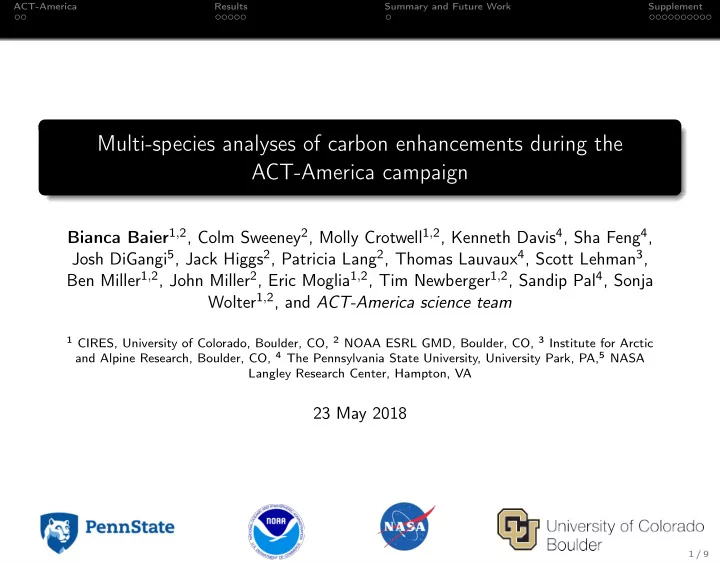

ACT-America Results Summary and Future Work Supplement Multi-species analyses of carbon enhancements during the ACT-America campaign Bianca Baier 1 , 2 , Colm Sweeney 2 , Molly Crotwell 1 , 2 , Kenneth Davis 4 , Sha Feng 4 , Josh DiGangi 5 , Jack Higgs 2 , Patricia Lang 2 , Thomas Lauvaux 4 , Scott Lehman 3 , Ben Miller 1 , 2 , John Miller 2 , Eric Moglia 1 , 2 , Tim Newberger 1 , 2 , Sandip Pal 4 , Sonja Wolter 1 , 2 , and ACT-America science team 1 CIRES, University of Colorado, Boulder, CO, 2 NOAA ESRL GMD, Boulder, CO, 3 Institute for Arctic and Alpine Research, Boulder, CO, 4 The Pennsylvania State University, University Park, PA, 5 NASA Langley Research Center, Hampton, VA 23 May 2018 1 / 9
ACT-America Results Summary and Future Work Supplement Regional inversion modeling Need to improve inversion model estimates of carbon (C) fluxes at regional scales to better predict future climate Our ability to accurately quantify fluxes on smaller scales is limited by model uncertainties Uncertainties in regional inversions: -regional transport, -background estimation, -assigning prior flux uncertainties in time/space, -sparse observations Peylin et al. (2013) 2 / 9
ACT-America Results Summary and Future Work Supplement ACT-America campaign Atmospheric Carbon and Transport - America Schematic: act-america.larc.nasa.gov OCO-2 underpass Fair-weather (sources) Frontal-crossing (transport) (retrieval evaluation) 3 / 9
ACT-America Results Summary and Future Work Supplement Fair weather flask analyses What do species measured in NOAA/GMD flasks tell us about regional CO 2 and CH 4 sources? Can flask samples approximate background carbon levels? Focus on fair weather flights for winter 2017 4 / 9
ACT-America Results Summary and Future Work Supplement Vertical greenhouse gas distributions: WT 2017 Column GHGs and CO increase moving NE throughout ACT domain: shift in air mass origin from lower latitudes (lower C) to higher latitudes (higher C) Important to quantify background contribution to regional sources Boundary layer enhancements ( ∆ [X] =[X] obs - [X] bg ) inform about local sources/sinks in each region 5 / 9
ACT-America Results Summary and Future Work Supplement Estimating background C levels using flasks Incorrect background determination can result in biased C fluxes within inversion domain Upper-atmospheric flask CO 2 vs. modeled background shows overlap (1 σ ), but some disagreement due to incorrect tracer transport 6 / 9
ACT-America Results Summary and Future Work Supplement Multi-species analysis In total, approximately 50 species measured in flasks: 7 / 9
ACT-America Results Summary and Future Work Supplement Multi-species analysis In total, approximately 50 species measured in flasks: Northeast/Midwest: source signatures from fossil fuel/ONG 7 / 9
ACT-America Results Summary and Future Work Supplement Multi-species analysis In total, approximately 50 species measured in flasks: Northeast/Midwest: source signatures from fossil fuel/ONG Midwest: large agricultural influence 7 / 9
ACT-America Results Summary and Future Work Supplement Multi-species analysis In total, approximately 50 species measured in flasks: Northeast/Midwest: source signatures from fossil fuel/ONG Midwest: large agricultural influence Southeast: weaker correlations with anthropogenic species, suggesting biogenic influence 7 / 9
ACT-America Results Summary and Future Work Supplement Multi-species analysis In total, approximately 50 species measured in flasks: Northeast/Midwest: source signatures from fossil fuel/ONG Midwest: large agricultural influence Southeast: weaker correlations with anthropogenic species, suggesting biogenic influence 7 / 9
ACT-America Results Summary and Future Work Supplement Radiocarbon: Northeastern U.S. We know 14 CO 2 is a tracer for recently-added fossil fuel CO 2 emissions: CO 2 obs = CO 2 bg + CO 2 ff + CO 2 bio Radiocarbon sampling during ACT concentrated in Northeast Biogenic CO 2 dominating CO 2 tot signal, while fossil fuel CO 2 constant 8 / 9
ACT-America Results Summary and Future Work Supplement Summary and future work For ACT WT’17, use GMD measurements in flasks for regional-scale source attribution, determining background levels → apply to CCGG network Regional transport: -Because sources well-known, use 14 CO 2 to evaluate tracer transport in inversions Utilize knowledge gained through campaign collaborations: -Apply understanding of transport via weather for more informed assimilation of network data in inversions (i.e. NOAA CarbonTracker) 9 / 9
Recommend
More recommend